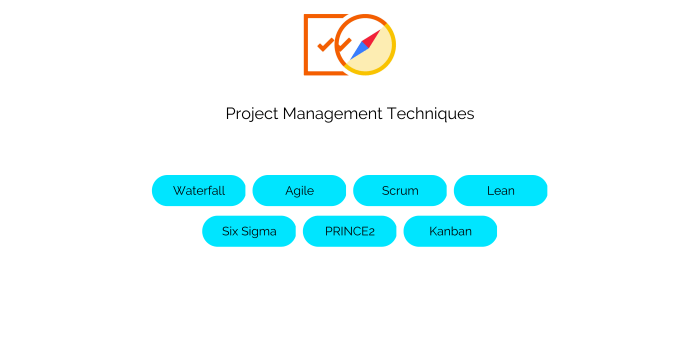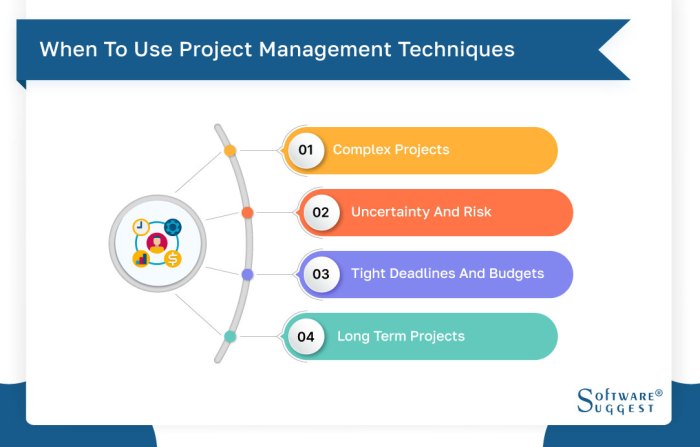Project Management Techniques take center stage in the world of business, offering a glimpse into the strategic tools and methods that drive successful projects. Get ready to dive into a world of innovation and optimization as we explore the dynamic landscape of project management.
Overview of Project Management Techniques

Project management techniques are strategies or methods used to plan, execute, and monitor a project from start to finish. These techniques are essential in ensuring that projects are completed on time, within budget, and meet the specified goals and objectives.
Importance of Utilizing Project Management Techniques
- Effective project management techniques help in organizing tasks, resources, and timelines efficiently.
- They facilitate better communication among team members and stakeholders.
- Project management techniques reduce risks and uncertainties, leading to a higher success rate for projects.
- They improve overall project performance and productivity.
Examples of Common Project Management Techniques
- Agile Project Management: An iterative approach that involves breaking down projects into smaller tasks and adapting to changes quickly.
- Waterfall Project Management: A sequential method where each phase of the project must be completed before moving on to the next.
- Scrum: A framework that emphasizes teamwork, accountability, and iterative progress towards project goals.
- Kanban: A visual system for managing work as it moves through a process, promoting continuous improvement and workflow efficiency.
Traditional Project Management Techniques
Traditional project management techniques are well-established methodologies used to plan, execute, and monitor projects. Some commonly used traditional techniques include the Waterfall model and the Critical Path Method.
Strengths of Traditional Project Management Techniques
- Clear project objectives and requirements are defined upfront.
- Progress is easily measurable and tracked.
- Sequential approach ensures a structured process.
Weaknesses of Traditional Project Management Techniques
- Less flexibility to accommodate changes during the project lifecycle.
- Risks may not be identified and addressed early enough.
- Can lead to scope creep if requirements are not well-defined.
Examples of When Traditional Project Management Techniques are Most Suitable
- Construction projects with clearly defined blueprints and timelines.
- Manufacturing processes that follow a specific order of operations.
- Projects where the end goal is well-understood and unlikely to change.
Agile Project Management Techniques
Agile project management is a modern approach to managing projects that focuses on flexibility, adaptability, and collaboration. The key principles of Agile project management include iterative development, continuous feedback, collaboration, and the ability to respond to change quickly.
Comparison with Traditional Methodologies
- Traditional project management methodologies follow a linear, step-by-step approach, while Agile project management emphasizes flexibility and adaptability through iterative cycles.
- Agile project management values customer collaboration over contract negotiation, allowing for changes and feedback throughout the project.
- Traditional methodologies require detailed planning upfront, while Agile allows for changes to be made as the project progresses based on feedback and evolving requirements.
- Agile project management promotes self-organizing teams that work together closely, fostering a collaborative and innovative work environment.
Enhancing Project Flexibility and Adaptability, Project Management Techniques
- Agile project management techniques, such as daily stand-up meetings and regular reviews, help teams stay on track and adapt to changes quickly.
- By breaking down the project into smaller, manageable tasks, Agile allows for adjustments to be made easily without disrupting the entire project timeline.
- Continuous feedback loops in Agile project management ensure that the project stays aligned with stakeholder expectations and can be adjusted as needed.
- Agile project management techniques promote a culture of transparency, collaboration, and continuous improvement, leading to successful project outcomes.
Hybrid Project Management Techniques
Hybrid project management combines elements of traditional and Agile project management methodologies to create a customized approach that best fits the needs of a specific project. This method allows teams to take advantage of the structure and predictability of traditional project management while also incorporating the flexibility and iterative nature of Agile.
Examples of Hybrid Project Management
When utilizing hybrid project management techniques, project managers may:
- Develop a detailed project plan using traditional methods, but maintain flexibility in adapting to changing requirements using Agile practices.
- Use sprints and iterative development cycles from Agile, but also establish clear milestones and deadlines typical of traditional project management.
- Combine traditional status reports and progress tracking with Agile daily stand-up meetings for efficient communication and problem-solving.
Benefits of Hybrid Project Management Techniques
Hybrid project management offers several advantages, including:
- Increased adaptability: Teams can adjust to changes in project scope or requirements while still maintaining an overall project plan.
- Improved risk management: By blending the structured risk analysis of traditional methods with Agile’s focus on early issue identification, teams can better anticipate and mitigate risks.
- Enhanced stakeholder engagement: Hybrid approaches allow for a balance between detailed project documentation for stakeholders who require it and more frequent, informal updates for those who prefer Agile communication styles.
Project Management Tools and Software
Project management tools and software play a crucial role in helping teams plan, execute, and monitor projects effectively. These tools provide a centralized platform for collaboration, task management, scheduling, and resource allocation.
Popular Project Management Tools
- 1. Trello: Known for its user-friendly interface and Kanban boards, Trello allows teams to create tasks, assign them, and track progress easily.
- 2. Asana: Asana offers a comprehensive project management solution with features like task dependencies, timelines, and integrations with other tools.
- 3. Jira: Primarily used by software development teams, Jira provides advanced issue tracking, agile project management, and customizable workflows.
- 4. Microsoft Project: A traditional project management tool, Microsoft Project offers features for creating Gantt charts, resource management, and project scheduling.
Comparison of Project Management Tools
| Tool | Key Features | Primary Use |
|---|---|---|
| Trello | Kanban boards, task assignments | Task management and collaboration |
| Asana | Task dependencies, timelines | Comprehensive project management |
| Jira | Issue tracking, agile project management | Software development |
| Microsoft Project | Gantt charts, resource management | Traditional project management |
Benefits of Project Management Software
- 1. Enhanced Efficiency: Project management software automates repetitive tasks, streamlines processes, and improves overall efficiency.
- 2. Improved Collaboration: Teams can collaborate in real-time, share updates, and communicate effectively through centralized platforms.
- 3. Better Resource Allocation: Software tools help in allocating resources efficiently, managing workloads, and optimizing project timelines.
Effective Communication in Project Management

Effective communication plays a crucial role in the success of project management. It ensures that everyone involved in the project is on the same page, understands their roles and responsibilities, and can work together efficiently towards the common goal.
Tips for Improving Communication Among Project Teams
- Establish clear channels of communication: Use tools like emails, instant messaging, and project management software to keep everyone informed.
- Encourage open and honest communication: Create a culture where team members feel comfortable sharing their thoughts, ideas, and concerns.
- Provide regular updates: Schedule weekly or bi-weekly meetings to discuss progress, challenges, and next steps.
- Active listening: Ensure that team members actively listen to each other’s ideas and feedback to avoid misunderstandings.
How Effective Communication Contributes to Project Success
Effective communication fosters collaboration, boosts team morale, and reduces the chances of misunderstandings or conflicts. When team members communicate clearly and openly, they can address issues promptly, make informed decisions, and adapt to changes effectively. This ultimately leads to successful project completion within the set timeframe and budget.